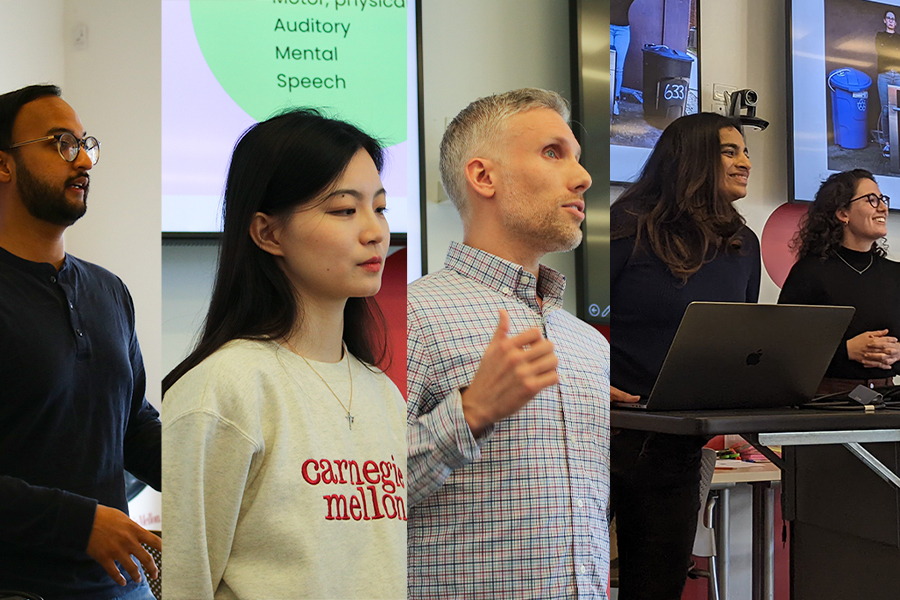
Exploring Innovation Mindset Final Presentations
Explore a selection of final projects from the Innovation Mindset class
By Jess Ignasky
What is the Innovation Mindset class?
The Innovation Mindset in Practice course challenges MIIPS Advanced students to take their thinking to the next level and apply critical thinking, an innovative mindset, disciplined research, and a thoughtful use of tools and methods to a topic of their choosing within the innovation realm.
This year, students were asked to submit two deliverables related to their topic. The first was a thesis paper relating to an area of research within innovation. The second allowed students to flex their creative muscles and could be presented as a TedTalk, podcast, video, or other forms of multimedia presentation about their topic.
Students in the 2022 MIIPS Advanced cohort presented a wide breadth of ideas from multisensory dining, to education in India, to inclusive design. Take a closer look at some of the presentations below:
Student Projects
- A Sustainable Solution to India’s Rural Water Problem
- Design Thinking for Education in India
- Where Food Meets the Five Senses, Unraveling the Realm of Immersive and Multisensory Dining
- Rediscovering Trust and Humanity in Contemporary Social Platforms
- Cultural Object & Entrepreneurship
- Linking Realities, a Bid to Identify a Spatial Protocol
- The Form of Everyday Computing
- Inclusive Design and Product Success
- Save the Microwaves: Encouraging Care Through Positive Person-Product Attachment
- Accelerating a Value-Based Care Adoption: A Behavioral Approach
- Why Politicians Should Be Banned from Social Media
Innovation Mindset Final Presentations
A Sustainable Solution to India’s Rural Water Problem

India is one of the most diverse countries in the world with a large population. While this large population and talent fosters opportunity for economic growth, it also brings challenges such as water access. Overall, India is one of the most water-stressed countries in the world. My paper explored how people in rural India could improve access to water using sustainable water practices - specifically rainwater harvesting. I found that the most effective rainwater harvesting technique for rural India would be roof-catchment rainwater harvesting. Additionally, I devised strategies focusing on education and cost to increase the implementation of rainwater harvesting in rural India. This is a topic that is close to my heart and I hope innovative and sustainable solutions appear in this space in India.

Over three decades later, India has introduced a revised national education policy (NEP 2020). This essay by Yash Banka & Raghvi Kabra sees the policy as a catalyst to overcome the systemic inertial buildup since the country’s colonial days. As design thinking practitioners, they hypothesize how a shift to a growth mindset could benefit the country’s education system and set a robust foundation for India to transform its economy with innovation at the forefront. They look outwards to draw inspiration and inwards to a nation expressing its pride, bringing together ideas and ways of thinking, and contextualizing them to work for the Indian education system. Interviews with stakeholders from the Ministry of Education, the curriculum design committee, and educators inform this study along with media articles, journal papers, and policy documents. Keeping the current classroom scenario in mind, a framework is introduced in which curiosity/exploration and review/reflection are emphasized in addition to the current cycle of teaching/learning and evaluation/absorption. Lastly, a thought experiment looks at how Scrum could be overlaid on this four-phase framework to bring about a new classroom culture.
Synopsis:
Dining is a way for us to indulge our senses and is a form of entertainment that extends beyond eating - which is a way to sustain a physiological need. Often, we associate dining or eating mainly with our sense of taste, while our other four senses fall secondary. Immersive multisensory dining explores how these other senses (visual, auditory, touch, smell) could be engaged to invoke elevated experiences at the table. Some elite restaurants around the world use expensive technologies to create such experiences. Our project explores how this could be done on a smaller scale for local businesses. We've engaged with several industry experts and even create an experience ourselves to come up with an outline for how it may be done.
Rediscovering Trust and Humanity in Contemporary Social Platforms

Synopsis:
Garrett set out to study the role that trust plays in human experience, particularly as interactions occur increasingly over digital platforms and society’s “ability to invent new things outpaces the rate we can civilize them” (quoting Kevin Kelly, founder of Wired Magazine). At this inflection point regarding public sentiment towards social platforms, he assesses whether the dominant services take human factors into account, with respect to collaboration and trust. Civility, like trust, must be cultivated and requires that we carve out space for discourse and collaboration, he says. He sees a need for business and government to better enable community-based governance and value exchange online and suggests drawing inspiration from town squares and bottoms-up collaborative traditions of the past. He also argues that the successes of digital commons (such as Wikipedia, open-source software, and microlending), reveal some clues for trusted, community-oriented platforms of the future.
Cultural Object & Entrepreneurship

SUMAIRHA MUMTAZ CHOUDHARY, MIIPS '22
Synopsis:
Objects that originate from and belong to a particular culture are increasingly crossing the geographical boundaries of the culture of their origin and are becoming available globally. The experience of consuming some of such objects in new contexts can be profound and meaningful but, in some cases, transactional and superficial. My thesis is about understanding what makes for a meaningful experience around a cultural object, the role entrepreneurs and designers can play in creating meaningful cultural object experiences, and the challenges that such businesses face.

Linking Realities, a Bid to Identify a Spatial Protocol

Synopsis:
As we move beyond our screens and towards a more immersive reality; the nature of our computing evolves into spatial dimensions, there is a need to identify a Spatial Protocol that can connect/ anchor our physical and digital worlds. Much like the HTTP protocol that connects our web pages, I tried to identify a spatial protocol that could connect ‘spaces’ across our worlds. I call this protocol, the ‘Universal Spatial Index’. I laid down a ‘tool for thought’, starting off by understanding the formation of spatial mental models in the human brain and using those insights to lay down the parameters of the USI; parameters like Spatial Mapping, Access permissions, Spheres, etc. I mainly used first principles thinking to come up with these concepts as there isn't much research out there about the Spatial Web.
The Form of Everyday Computing

Synopsis:
The Form of Everyday Computing is an article that introduces the history of computer development and looks into the future. It demonstrates how the interaction between human and computing devices evolves and how the industry has changed. In the end, it also gives practical advice for practitioners based on the findings of the study.

Synopsis:
As increasing products today aim to serve a wide range of users, inclusive design is becoming a critical topic. In this article, we proved the positive correlation between inclusive design and product success by stating that inclusive design is imperative for products to achieve higher market share and customer satisfaction and is a requirement for bringing products to be mainstream solutions. Five suggestions on functionalities, content, pricing, infrastructure, and organization were provided to help relevant practitioners to design better communication features or tools and guide different software development companies and teams to make more ethical decisions.
Synopsis:
With the rapid depletion of the earth’s resources and the wasteful consumption habits of many worldwide, it’s now more important than ever to engage in circular practices, such as repair, that will make our future a more sustainable one. When it comes to many objects, especially electronics and household appliances, repairing is often difficult. From a pragmatic perspective, obstacles such as the limited availability of spare parts, expensive or inconvenient labor, or inaccessibility of support all hinder repair. However, there’s also an emotional and personal side to repair. If one of your appliances were to break today, would you make an effort to repair it? If so, how much effort would you be willing to put in and what does it depend on? If not, why not, and what could be done to influence your behavior? Through our exploration, we study the concept of product-person attachment, which refers to the relationship between a person and a product. Fostering a positive, meaningful person-product relationship is one way that acts of care towards products, such as repair, can be encouraged on an individual scale.

Accelerating a Value-Based Care Adoption: A Behavioral Approach

Synopsis:
Behavioral Economics and Social Psychology are core components of any solution that will improve the adoption of large-scale Value-Based Care programs in the US Healthcare system. I believe that the core problems in the adoption of value-based care systems stem from a lack of trust in the current provider-payer-patient system, a misalignment in what stakeholders believe other stakeholders value, and inertia or a low willingness to change without some external force. While each of these problems can have a multitude of solutions, none of them can be solved without looking at how they affect people (both patients and providers) and changing how these groups view incentives and make decisions. Psychological barriers like present bias, choice overload, and loss aversion are just some of the issues that need to be addressed. Large-scale adoption is usually based on a group of successful pilot studies and mid-sized programs. Testing out solutions, with behavioral economics practices mixed in, has shown the behavioral changes needed to help facilitate the implementation.
Why Politicians Should Be Banned from Social Media

This past summer I worked as a social media content analyst at the Center of Democracy and Technology, helping investigate the misinformation and abuse faced by women of color in public offices across the country. This inspired me to pursue my own research project on political content moderation on social media. My master's essay examines the effects of social media on political discourse by looking at current content moderation practices, the algorithms dictating what users see, and the resulting polarization in our political identities which increasingly informs offline behavior. This project also involved visualizing data collected from social media platforms (Facebook and Twitter) highlighting how and what is shared to underscore negative biases and the abundance of misinformation–particularly in political content. Through these examinations, I provided recommendations that might help stimulate critical thinking and open-minded political conversations, rather than the inflammatory and extreme messaging currently being rewarded.









